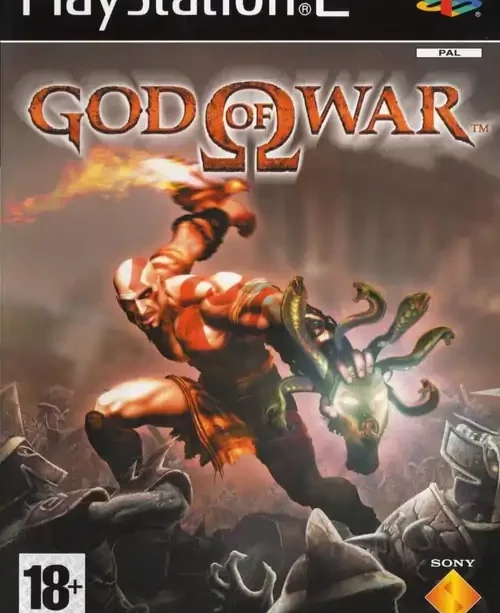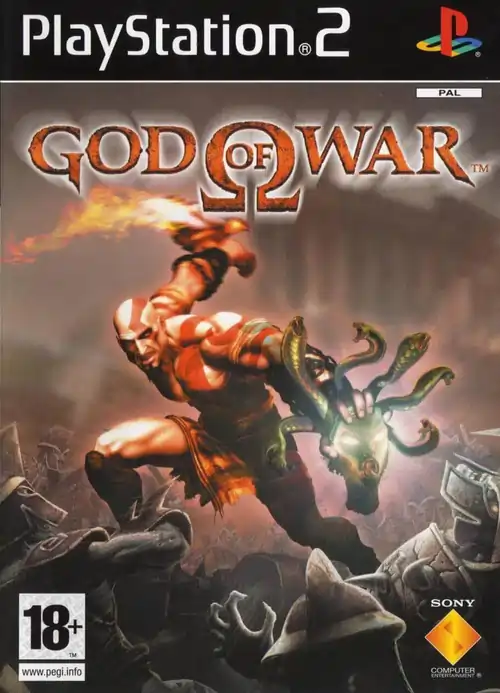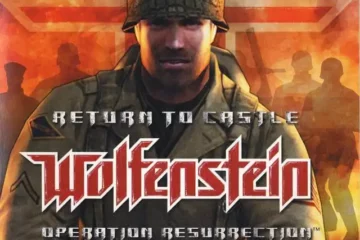
God of War

Console: PS2
Publisher: SCEA, Sony
Genre: Action, Adventure
Region: WW
Released: March 22, 2005
File size: 6.98 GB
Experience the origins of Kratos’ wrath in this brutal mythological adventure.
Back in 2005, when most gamers were still getting used to the PlayStation 2’s capabilities, Santa Monica Studio dropped something absolutely revolutionary. God of War didn’t just arrive on the scene – it kicked down the door and completely rewrote what we thought action-adventure games could be. This wasn’t your typical hack-and-slash title; it was a masterclass in brutal combat, cinematic storytelling, and the kind of mature themes that made parents double-check game ratings.
The Birth of a Gaming Legend
Picture this: it’s 2002, and David Jaffe walks into Santa Monica Studio with what most people would call a crazy idea. He wanted to create something that had never been done before – imagine taking the fast-paced action from Devil May Cry, mixing it with the puzzle-solving brilliance of Ico, then wrapping the whole thing in Greek mythology. Sounds ambitious? That was just Tuesday for Jaffe.
The team wasn’t starting from scratch, though. They had this racing game engine from Kinetica (you know, that futuristic racing game from 2001 that flew under most people’s radar). Instead of building something new, they took that engine and basically performed digital surgery on it. What came out the other side was something that pushed the PS2 harder than most games dared to try.
Where Inspiration Struck
Every great game has its “aha!” moments, and God of War had several. Jaffe wasn’t shy about where he found his muse. The Onimusha series got his creative wheels turning – “What if we did that, but with Greek mythology instead of Japanese demons?” he thought. The 1981 movie Clash of the Titans provided that epic, larger-than-life atmosphere that made you feel like you were actually battling gods.
But here’s a fun fact that most people don’t know: our beloved Kratos almost had a completely different name. During development, the team called him “Dominus.” Can you imagine yelling “Dominus of War!” instead? It just doesn’t have the same ring to it, does it? The game itself went by “Dark Odyssey” until the marketing team stepped in and suggested something with a bit more punch.
Combat That Changed Everything
Let’s talk about what made God of War’s combat system so special. This wasn’t your typical button-mashing affair. The development team promised players would have access to 15-25 different attacks with the main weapon alone. But here’s what made it brilliant – you could string these moves together in almost any combination you wanted. It was like having a martial arts encyclopedia at your fingertips.
The Blades of Chaos: Your Best Friends
Those iconic chained blades weren’t just weapons – they were an extension of Kratos himself. The way they worked was pure genius. You had your standard close-range attacks, sure, but the real magic happened when you learned to use the chains. Suddenly, you could grab enemies from across the room, swing around pillars, and create combinations that looked like something out of a martial arts movie.
Key Combat Features:
- Chain-based attacks that let you control distance and positioning
- Fire elemental damage that gets stronger as you upgrade
- Aerial juggling for those satisfying extended combos
- Wall-running and climbing that turned the environment into part of your arsenal
The upgrade system was straightforward but addictive. Every enemy you defeated dropped Red Orbs – think of them as ancient Greek experience points. Collect enough, and you could upgrade your blades through five different levels. Each upgrade didn’t just increase damage; it unlocked entirely new moves. By the end of the game, your combat options were almost overwhelming in the best possible way.
Beyond the Blades: Secondary Arsenal
While the Blades of Chaos were your bread and butter, God of War didn’t stop there. Hidden throughout Pandora’s Temple (we’ll get to that maze later), you could find the Blade of Artemis. This massive two-handed sword was like bringing a cannon to a knife fight – slower than your chains, but when you needed to deal with heavily armored enemies, nothing else came close.
Then there were the magic spells – four of them, each more devastating than the last:
Magic Arsenal:
- Zeus’ Fury – Lightning bolts for when you needed to zap enemies from a safe distance
- Medusa’s Gaze – Turn enemies to stone, then shatter them for massive damage
- Poseidon’s Rage – Area-of-effect lightning that cleared rooms like nobody’s business
- Army of Hades – Summon the dead to fight alongside you (because why fight fair?)
The Hunt for Secrets and Collectibles
God of War was generous with its secrets, but it made you work for them. This wasn’t the kind of game where you’d stumble across power-ups by accident. Every collectible was placed with purpose, often in spots that required either excellent exploration skills or the kind of persistence that separates casual players from completionists.
Essential Power-Ups
The collectible system was beautifully simple. Gorgon Eyes came in red orbs – find six, and your maximum health increased. These weren’t just lying around in plain sight; the developers tucked them away in hidden chests, behind breakable walls, and in spots that required some serious platforming skills to reach.
Phoenix Feathers worked the same way but for your magic meter. These blue collectibles were often placed in the most challenging locations – the kind of spots where you’d see them, know exactly what they were, and then spend the next twenty minutes figuring out how to actually get to them.
Pro Tip for Collectors:
The Muse Keys are probably the most well-hidden secrets in the game. There are only two of them, both located in Pandora’s Temple challenges. Find both, and you’ll unlock a secret chamber packed with health upgrades, magic boosts, and enough experience orbs to make the rest of the game significantly easier.
Easter Eggs That Blew Our Minds
The development team at Santa Monica Studio had a sense of humor, and they weren’t afraid to show it. Complete the game on God Mode (the hardest difficulty), and you’d unlock hidden phone numbers. Yes, actual phone numbers you could call to hear recordings of Kratos having conversations with David Jaffe himself. It was the kind of easter egg that made you feel like you were part of an exclusive club.
But the secret that really got the community talking was the hidden HD mode. This involved a mysterious URL – “islandofroads.org” – and a series of button combinations that unlocked high-resolution graphics. This was 2005, remember, when HD gaming was still a pipe dream for most console players.
Boss Battles That Defined Epic
If there’s one thing God of War did better than almost any game before it, it was making you feel like you were actually fighting gods and monsters. Each boss battle was less of a fight and more of an interactive movie where you played the starring role.
The Hydra King: Your Welcome to Hell
The game’s opening boss fight set the tone for everything that followed. You’re on a ship, there’s a massive three-headed sea monster trying to turn you into lunch, and the game basically says, “Here, learn our combat system while fighting for your life.” It was brilliant tutorial design disguised as an epic boss battle.
The fight itself was straightforward – take out the two smaller heads first, then focus all your attention on the main head. But what made it memorable was the scale. This wasn’t just a big enemy; it was a living disaster that made you feel both powerful and vulnerable at the same time.
Medusa: Beauty and the Beast
The Medusa fight was where the game showed off its puzzle-solving chops. Sure, you could hack and slash your way through most encounters, but here, you needed strategy. Look directly at her, and you’d turn to stone. The solution? Use her own power against her minions, then strike when she was vulnerable.
Winning this fight gave you one of the game’s most satisfying rewards – Medusa’s head became a permanent weapon in your arsenal. Nothing quite compared to turning a room full of enemies to stone, then watching them crumble with a single strike.
The Final Showdown: Ares
The climactic battle against Ares wasn’t just a boss fight – it was a statement. This was Kratos taking on the God of War himself, and the game pulled out every technical trick it had learned. The battle had multiple phases, each more intense than the last, culminating in an emotional sequence that perfectly captured what the entire journey had been building toward.
What made this fight special wasn’t just its scale (though fighting a god the size of a skyscraper was pretty impressive). It was the personal stakes. This wasn’t just about defeating another enemy; it was about Kratos finally confronting the source of his torment.
Technical Magic on Aging Hardware
Here’s something that still impresses me to this day: God of War looked absolutely stunning on hardware that was already four years old when the game launched. The PlayStation 2’s Emotion Engine CPU and Graphics Synthesizer GPU were not powerhouses by any stretch, but Santa Monica Studio managed to create visuals that held their own against early PlayStation 3 titles.
The game supported progressive scan output (480p for you tech specs enthusiasts), which was still a relatively new feature in 2005. It also offered 16:9 widescreen support and Dolby Pro Logic II audio. These might seem like basic features now, but back then, they were the kind of technical achievements that separated great games from good ones.
Technical Achievements:
- Stable frame rate even during the most chaotic battle sequences
- Seamless area transitions that hid loading times brilliantly
- Dynamic lighting effects that brought Greek mythology to life
- Particle systems that made magic spells feel genuinely magical
Journey Through Ancient Greece
God of War’s adventure took you through 16 major areas, each with its own personality and challenges. This wasn’t just a series of combat arenas connected by hallways; it was a carefully crafted journey that told a story through its environments.
Early Adventures
The game started you off on the Aegean Sea with that memorable Hydra battle, then quickly moved you to the Gates of Athens. These early areas served as your introduction to both the combat system and the world itself. By the time you reached Athens Town Square, you had a solid grasp of the basics and were ready for bigger challenges.
Pandora’s Temple: The Heart of the Experience
If God of War had a defining location, it was Pandora’s Temple. This wasn’t just a dungeon – it was a masterpiece of level design that combined combat, puzzles, and exploration in ways that few games have matched before or since. The temple’s rotating rings mechanism was the kind of environmental puzzle that made you feel genuinely clever when you figured it out.
Each challenge within the temple – Atlas, Poseidon, and Hades – tested different aspects of your skills. The Challenge of Atlas required brute strength and timing. Poseidon’s challenge was all about swimming and climbing with precision. The Challenge of Hades? That was your journey into the underworld itself, complete with all the psychological horror you’d expect.
Beyond the Main Quest
Finishing God of War was just the beginning. The game was packed with unlockable content that gave you plenty of reasons to dive back in. This was the kind of bonus material that actually added value to your purchase.
Difficulty That Actually Mattered
The three difficulty modes weren’t just damage multipliers. Hero Mode was perfect for most players – challenging but fair. Spartan Mode ramped things up for experienced action game veterans. God Mode? That was reserved for players who wanted to prove something to themselves. Completing God Mode unlocked those famous secret phone numbers and other exclusive content.
Challenge of the Gods
Ten unique combat trials that pushed your skills to their absolute limits. These weren’t just harder versions of regular fights; they were carefully designed scenarios that forced you to use every tool in your arsenal. Completing them all was a badge of honor in the God of War community.
Questions Players Always Ask
How long does it take to beat God of War?
Most players can expect to spend 8-10 hours on the main story. If you’re the type who needs to find every secret and complete every challenge, you’re looking at closer to 12-15 hours. The game respects your time – it’s long enough to feel substantial without overstaying its welcome.
What should I upgrade first?
Focus on the Blades of Chaos early and often – you’ll use them throughout the entire game. For magic, Zeus’ Fury is your best bet for early upgrades since it gives you reliable ranged damage when you need breathing room.
Can I miss any collectibles permanently?
Nope! One of God of War’s best design decisions was allowing you to return to previous areas. If you missed a Gorgon Eye or Phoenix Feather, you can always backtrack once you have the right abilities.
What happens if I die during a boss fight?
The checkpoint system is quite generous. Most boss fights have multiple checkpoints, so you’ll restart from the current phase rather than the very beginning. It keeps the difficulty challenging without being punishing.
A Legacy That Changed Gaming Forever
Looking back nearly two decades later, it’s clear that God of War didn’t just succeed – it fundamentally changed what players expected from action games. The cinematic camera work that felt so revolutionary? It became industry standard. Those Quick Time Events that everyone either loved or hated? They showed up everywhere. The mature, emotional storytelling that treated players like adults? That opened doors for countless games that followed.
But beyond its influence on game design, God of War proved something important: original intellectual properties could compete with established franchises. At a time when sequels dominated the industry, Santa Monica Studio created something entirely new and made it feel essential. They didn’t just make a good game; they created a cultural phenomenon.
The game’s success also demonstrated that the PlayStation 2 still had plenty of life left in it. While everyone was talking about the next generation of consoles, God of War showed that creative developers could still squeeze impressive experiences out of aging hardware. It was a master class in optimization and artistic vision working together.
The Foundation of an Empire
God of War (2005) stands as more than just an exceptional action game – it represents a pivotal moment in PlayStation history when Sony Santa Monica Studio proved that taking risks could pay off in spectacular ways. The game’s perfect fusion of brutal combat, emotional storytelling, and technical excellence created a template that developers still study today.
Whether you experienced it through the original PlayStation 2 version or discovered it through one of the many re-releases and collections, God of War remains essential gaming. Its influence shaped not only its own successful franchise but the entire action-adventure genre, establishing Santa Monica Studio as one of gaming’s premier developers and Kratos as one of the medium’s most recognizable characters.
The journey from “Dark Odyssey” to God of War represents the collaborative effort of passionate developers who refused to accept limitations. Instead, they chose to redefine what was possible on PlayStation 2. Their legacy continues to inspire new generations of game creators and remains a testament to the power of innovative design and uncompromising artistic vision.
Related Articles:
Tom Clancy’s Splinter Cell – Chaos Theory
October 24, 2025Time Crisis 3
October 24, 2025Return to Castle Wolfenstein: Operation Resurrection
October 24, 2025



